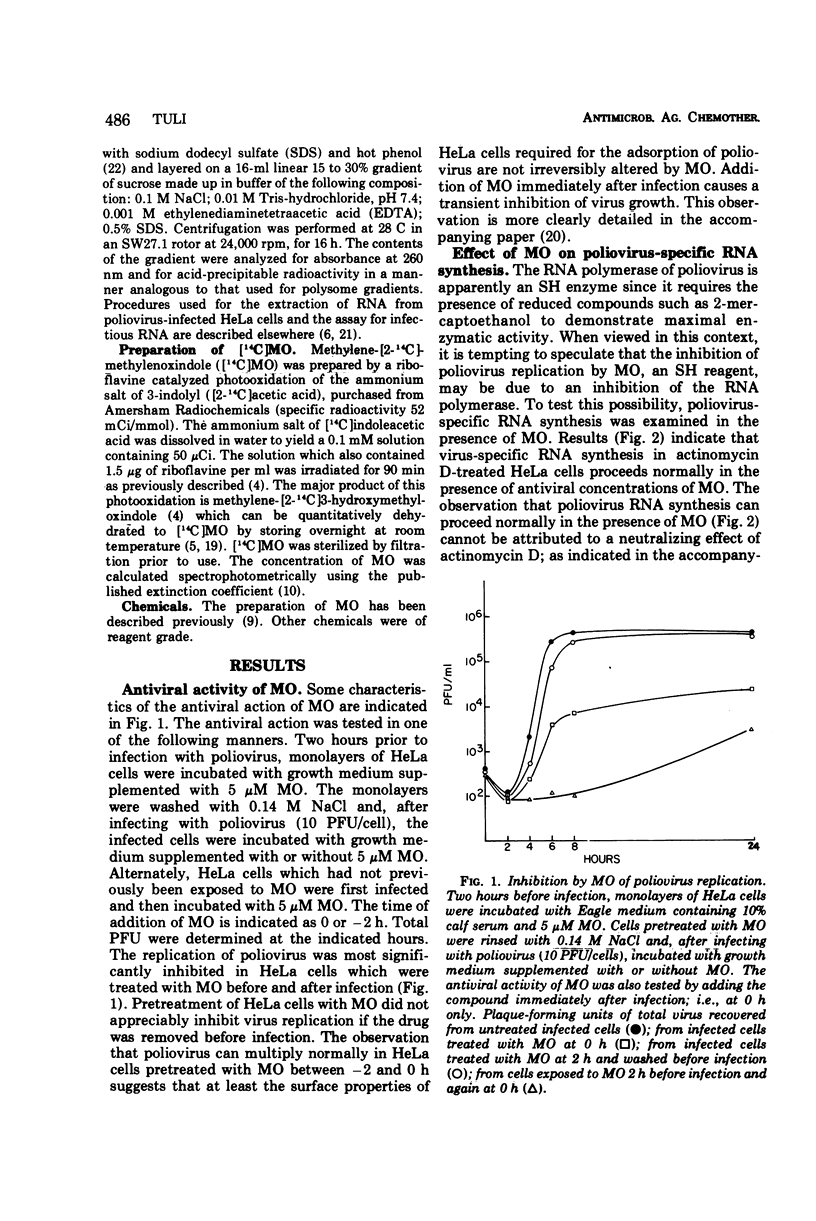Abstract
The biochemical basis underlying the antiviral action of 3-methyleneoxindole (MO), a plant metabolite, was examined in HeLa cells infected with poliovirus. In the presence of antiviral concentrations of MO, poliovirus-specific ribonucleic acid (RNA) synthesis can proceed normally, and the RNA synthesized under such conditions is infectious. It is suggested that the ability of MO to bind to ribosomes of HeLa cells may underlie the antiviral affect. Data are presented which indicate that poliovirus messenger RNA cannot attach to those ribosomes which already are bound to MO. Consequently, virus-specific polysomes cannot be recovered from infected cells treated with antiviral concentrations of MO. In contrast, antiviral concentrations of MO do not prevent the formation of polysomes in uninfected HeLa cells.
Full text
PDF






Selected References
These references are in PubMed. This may not be the complete list of references from this article.
- BALTIMORE D., FRANKLIN R. M. EFFECTS OF PUROMYCIN AND P-FLUOROPHENYLALANINE ON MENGOVIRUS RIBONUCLEIC ACID AND PROTEIN SYNTHESIS. Biochim Biophys Acta. 1963 Nov 22;76:431–441. [PubMed] [Google Scholar]
- Baltimore D., Girard M., Darnell J. E. Aspects of the synthesis of poliovirus RNA and the formation of virus particles. Virology. 1966 Jun;29(2):179–189. doi: 10.1016/0042-6822(66)90024-9. [DOI] [PubMed] [Google Scholar]
- Baltimore D., Huang A. S., Stampfer M. Ribonucleic acid synthesis of vesicular stomatitis virus, II. An RNA polymerase in the virion. Proc Natl Acad Sci U S A. 1970 Jun;66(2):572–576. doi: 10.1073/pnas.66.2.572. [DOI] [PMC free article] [PubMed] [Google Scholar]
- Basu P. S., Tuli V. Enzymatic dehydration of 3-hydroxymethyloxindole. Plant Physiol. 1972 Oct;50(4):503–506. doi: 10.1104/pp.50.4.503. [DOI] [PMC free article] [PubMed] [Google Scholar]
- Basu P. S., Tuli V. The Binding of Indole-3-acetic Acid and 3-Methyleneoxindole to Plant Macromolecules. Plant Physiol. 1972 Oct;50(4):507–509. doi: 10.1104/pp.50.4.507. [DOI] [PMC free article] [PubMed] [Google Scholar]
- Bishop J. M., Koch G. Purification and characterization of poliovirus-induced infectious double-stranded ribonucleic acid. J Biol Chem. 1967 Apr 25;242(8):1736–1743. [PubMed] [Google Scholar]
- Carbon J., David H. Studies on the thionucleotides in transfer ribonucleic acid. Addition of N-ethylmaleimide and formation of mixed disulfides with thiol compounds. Biochemistry. 1968 Nov;7(11):3851–3858. doi: 10.1021/bi00851a010. [DOI] [PubMed] [Google Scholar]
- Champney W. S., Sypherd P. S. Absence of thiolated nucleotides in ribosomal RNA of E. coli. Biochem Biophys Res Commun. 1970 Dec 9;41(5):1328–1334. doi: 10.1016/0006-291x(70)90234-2. [DOI] [PubMed] [Google Scholar]
- HINMAN R. L., BAUMAN C., LANG J. The conversion of indole-3-acetic acid to 3-methyleneoxindole in the presence of peroxidase. Biochem Biophys Res Commun. 1961 Jul 26;5:250–254. doi: 10.1016/0006-291x(61)90156-5. [DOI] [PubMed] [Google Scholar]
- Huang A. S., Balitmore D. Initiation of polyribosome formation in poliovirus-infected HeLa cells. J Mol Biol. 1970 Feb 14;47(3):275–291. doi: 10.1016/0022-2836(70)90302-5. [DOI] [PubMed] [Google Scholar]
- Huang A. S., Baltimore D., Bratt M. A. Ribonucleic acid polymerase in virions of Newcastle disease virus: comparison with the vesicular stomatitis virus polymerase. J Virol. 1971 Mar;7(3):389–394. doi: 10.1128/jvi.7.3.389-394.1971. [DOI] [PMC free article] [PubMed] [Google Scholar]
- LEVINTOW L., THOREN M. M., DARNELL J. E., Jr, HOOPER J. L. Effect of p-fluorophenylalanine and puromycin on the replication of poliovirus. Virology. 1962 Mar;16:220–229. doi: 10.1016/0042-6822(62)90241-6. [DOI] [PubMed] [Google Scholar]
- PENMAN S., BECKER Y., DARNELL J. E. A CYTOPLASMIC STRUCTURE INVOLVED IN THE SYNTHESIS AND ASSEMBLY OF POLIOVIRUS COMPONENTS. J Mol Biol. 1964 Apr;8:541–555. doi: 10.1016/s0022-2836(64)80010-3. [DOI] [PubMed] [Google Scholar]
- Penman S., Scherrer K., Becker Y., Darnell J. E. POLYRIBOSOMES IN NORMAL AND POLIOVIRUS-INFECTED HELA CELLS AND THEIR RELATIONSHIP TO MESSENGER-RNA. Proc Natl Acad Sci U S A. 1963 May;49(5):654–662. doi: 10.1073/pnas.49.5.654. [DOI] [PMC free article] [PubMed] [Google Scholar]
- Rosbash M., Penman S. Membrane-associated protein synthesis of mammalian cells. I. The two classes of membrane-associated ribosomes. J Mol Biol. 1971 Jul 28;59(2):227–241. doi: 10.1016/0022-2836(71)90048-9. [DOI] [PubMed] [Google Scholar]
- SREEVALSAN T., LOCKART R. Z., Jr INHIBITION BY PUROMYCIN OF THE INITIATION OF SYNTHESIS OF INFECTIOUS RNA AND VIRUS BY CHICKEN EMBRYO CELLS INFECTED WITH WESTERN EQUINE ENCEPHALOMYELITIS VIRUS. Virology. 1964 Sep;24:91–96. doi: 10.1016/0042-6822(64)90151-5. [DOI] [PubMed] [Google Scholar]
- Tuli V. Bactericidal action of sulfhydryl binding compounds. Antimicrob Agents Chemother. 1973 Feb;3(2):157–161. doi: 10.1128/aac.3.2.157. [DOI] [PMC free article] [PubMed] [Google Scholar]
- Tuli V., Moyed H. S. Inhibitory oxidation products of indole-3-acetic Acid: 3-hydroxymethyloxindole and 3-methyleneoxindole as plant metabolites. Plant Physiol. 1967 Mar;42(3):425–430. doi: 10.1104/pp.42.3.425. [DOI] [PMC free article] [PubMed] [Google Scholar]
- Tuli V., Moyed H. S., Stevenson D., Gordon I. Antiviral activity of 3-methyleneoxindole. Antimicrob Agents Chemother. 1974 May;5(5):479–484. doi: 10.1128/aac.5.5.479. [DOI] [PMC free article] [PubMed] [Google Scholar]
- Vaheri A., Pagano J. S. Infectious poliovirus RNA: a sensitive method of assay. Virology. 1965 Nov;27(3):434–436. doi: 10.1016/0042-6822(65)90126-1. [DOI] [PubMed] [Google Scholar]


